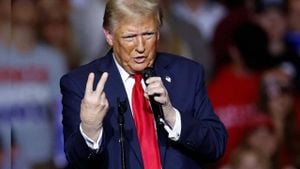With the 2024 election fast approaching, Vice President Kamala Harris is making headlines across the nation, especially with her substantial lead over former President Donald Trump in California. According to new polling from UC Berkeley’s Institute of Governmental Studies, which partnered with the Los Angeles Times, Harris is currently leading Trump with 57% of likely voters compared to his 35%. This margin, consistent with previous months, signals her strong position as the Democratic candidate heading for election day.
Despite the solid numbers, Harris's lead is noteworthy less expansive than President Joe Biden's victory margin of nearly 30 points the last time California voted for president. “You're not seeing the same kind of strong support for the Democratic ticket among Latinos,” remarked Mark DiCamillo, director of the poll. This shift seems significant, particularly considering the growing influence of Latino and Asian American voters within the electorate of California, accounting for over one-third of the state’s voters.
Currently, around 5% of voters remain undecided, with about 3% backing other candidates. Harris, who has been actively barnstorming through various swing states alongside Trump, faces unique challenges differing from her predecessor. This year, for example, she's seeing reduced support from key demographics—especially Latino and Asian American men, contributing to her diminished edge.
Polling reveals Harris's approval at 57% among Latino voters and 56% among Asian American voters, with some sources indicating as low as 50% approval among Latino and Asian American men. Mark DiCamillo underscored the potential ramifications this trend could have on other pivotal western swing states like Arizona and Nevada, where similarly diverse communities play defining roles.
Interestingly, Harris has gained favor among white voters. Polling suggests this demographic supports her at rates higher than they did Biden, who won among them by 51% to 47% against Trump. Currently, Harris leads this group 58% to 36%, and 67% of college-educated white voters back her. Conversely, less formally educated white voters tilt toward Trump, as half aligned with him, compared to 45% who favor Harris.
On the ground, Harris's dominance appears evident within California's metropolitan areas, such as Los Angeles and the Bay Area. Trump, on the other hand, garners solid backing within the San Joaquin Valley, with voters split roughly down the middle in Orange County. Despite such fragmentation, DiCamillo expressed confidence Harris will carry California, as has every Democratic candidate since President George H.W. Bush defeated Michael Dukakis back in 1988.
Meanwhile, Rep. Adam B. Schiff comfortably holds his ground against former Dodger All-Star Steve Garvey as they battle for the U.S. Senate seat vacated by the late Dianne Feinstein. Schiff enjoys 55% support against Garvey’s 34%. DiCamillo described the race between Schiff and Garvey as lacking the tension found typically between competitors, likely pointing toward Schiff's solid standing.
Despite their strengthened positions, the atmosphere around the elections remains charged. Anna Kelly from the Republican National Committee claimed Trump will work for all Americans, emphasizing states traditionally seen as Democratic strongholds. Meanwhile, concerns about shifting voter demographics are leading analysts to focus on how these trends could influence outcomes beyond California.
Even as polling figures present promising prospects for Harris and Schiff, the wider climate leading to the election leaves many unanswered questions about the electoral sentiments of various demographics. Observers are paying close attention to the pronounced divide between men's and women's voting preferences, particularly amid heightened discourse surrounding women's rights issues.
Looking beyond the polling and race dynamics, recent celebrity endorsements have also sought to bolster Harris's image leading up to the election. Big names like Beyoncé, Oprah Winfrey, and Eminem have all come out to show their support for Harris. Yet, some claims had circulated initially alleging these stars were compensated hefty sums for their backing—a charge which has been thoroughly debunked.
Social media has been rife with accusations of the Harris campaign allegedly paying these celebrities $20 million collectively for their endorsements. Fact-checkers confirmed no credible evidence of such transactions exists. For example, Winfrey remarked via Instagram, clarifying she received no personal payment for her endorsement, only stating fees were paid to crew members handling event production.
Harris has actively campaigned through diverse avenues, from star-studded rallies to traditional meetings with voters on the ground. The influence of celebrity endorsements cannot be overlooked, but they are only one piece of the broader strategy intended to galvanize support—from rallies to community outreach.
Endorsements became of significant discussion as the Harris campaign sought to maximize its appeal, particularly among younger voters and groups disillusioned with traditional political structures. Many younger voters resonate with the messages conveyed by these celebrities, and Harris's interactions with them aim to not only attract attention but to inject vitality and social relevance to her campaign.
The backdrop of celebrity culture and grassroots campaigning seamlessly intertwines during election season, prompting many to re-examine the symbiotic relationship between political candidates and pop culture icons. While celebrity backing might attract attention, it could significantly falter without genuine engagement and solid policies.
Beyond the glitz and noise, strong foundations of political strategy are firmly at play for both Harris and Schiff as they navigate the treacherous waters leading to the 2024 election. Their campaigns are marked not just by celebrity endorsements but by calculated efforts to understand and engage the electorate’s changing dynamics within the broader political environment.
On the horizon, the trends observed could very well signal tides changing for Harris, particularly if the drop among pivotal demographics emerges consistently across western swing states. How she and her campaign will adapt to these dynamics remains to be seen. Observers note, as the final weeks tick away, each campaign must dig deep to connect with the electorate, urging them to not only cast their votes but to stand behind their candidates excitedly.
Polling not only shows support but also highlights the complexity within the electorate's shifting sentiments. The pathway to November winds through apprehensive terrain, and both sides are steeling themselves for what might be take shape as one of the most consequential elections yet.



